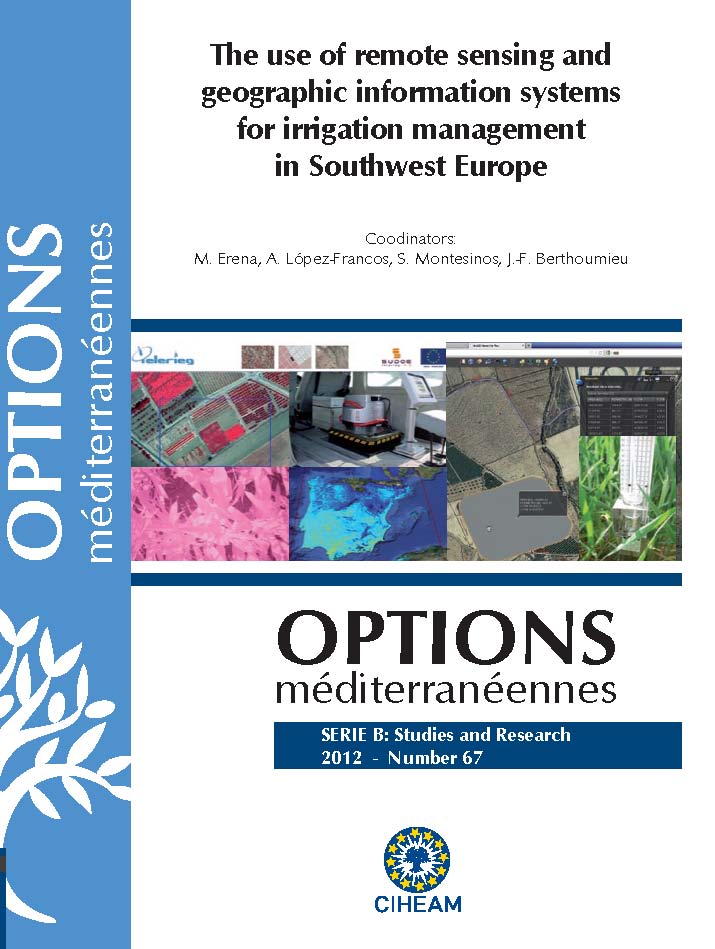| Article précédent | p. 185-191 | Article suivant |
Contribution of airborne remote sensing to high-throughput phenotyping of a hybrid apple population in response to soil water constraints
In this study, we developed a remote sensing approach, normally applied to management of crop irrigation, with the purpose of phenotyping a plant population in the field. The experiment was performed on 'Starkrimson' x 'Granny Smith' apple progeny (122 hybrids, 4 replicates) at adult stage, cultivated in field on Diaphen platform (INRA Montpellier, France). Airborne images acquisition in RGB and NIR bands permit to compute the Normalized Difference Vegetation Index (NDVI), while differences between tree canopy surface measured by thermal IR imaging (Ts) and air temperature (Ta) made it possible to calculate water stress indices. The Water Deficit Index (WDI), derived from the Crop Water Stress Index (CWSI), was considered for its applicability to discontinuous plant cover. WDI was computed on each individual tree, and focused on its central zone (60 cm diameter buffer). The first results showed significant genotypic effects and drought effects for indices during imposed summer water shortage, without interaction between them. Moreover, this first experiment permits to determine field measurements that are necessary to validate the method, linking image interpretation and tree water status variables.
Dans cette étude, nous avons développé une approche par la télédétection, normalement appliquée à la gestion de l'irrigation, afin de réaliser le phénotype d'une population végétale aux champs. L'expérience a été effectuée sur une descendance de pommiers 'Starkrimson' x 'Granny Smith' (122 hy bri - des, 4 répétitions) au stade adulte, cultivés aux champs sur plate-forme Diaphen (INRA Montpellier, France). L'acquisition d'images aériennes dans les bandes RGB et NIR a permis de calculer l'Indice de Végétation Normalisé (NDVI), tandis que les différences entre la surface de la canopée des arbres mesurée par images thermiques IR (Ts) et la température de l'air (Ta) ont permis de calculer les indices de stress hydrique. L'Indice de Déficit Hydrique (WDI), dérivé de l'Indice de Stress Hydrique des Cultures (CWSI), a été considéré en raison de son applicabilité à un couvert végétal discontinu. Le WDI a été calculé pour chaque arbre individuel, en se focalisant sur sa zone centrale (avec une zone-tampon de 60 cm de diamètre). Les premiers résultats montrent des effets génotypiques significatifs et des effets de la sécheresse pour les indices pendant la pénurie d'eau imposée en été, sans interaction entre eux. De plus, cette première expérience permet de déterminer les mesures de terrain qui sont nécessaires pour valider la méthode, mettant en rapport l'interprétation des images et les variables liées à l'état hydrique des arbres.
- [ Afficher ]
- [ Télécharger ]
- [ Exporter la citation ]
Vous pouvez télécharger la citation au format :
- [ Imprimer ]
-
Mots-clés
COLLECTE DE DONNEES, HYBRIDE, MALUS, PHENOTYPE, STRESS DU A LA SECHERESSE, TELEDETECTION, VARIATION GENETIQUECiter cet article
Virlet N., Martínez S., Lebourgeois V., Labbé S., Regnard J.L. Contribution of airborne remote sensing to high-throughput phenotyping of a hybrid apple population in response to soil water constraints. In : Erena M. (coord.), López-Francos A. (coord.), Montesinos S. (coord.), Berthoumieu J.-P. (coord.). The use of remote sensing and geographic information systems for irrigation management in Southwest Europe. Zaragoza : CIHEAM / IMIDA / SUDOE Interreg IVB (EU-ERDF), 2012. p. 185-191. (Options Méditerranéennes : Série B. Etudes et Recherches; n. 67). http://om.ciheam.org/om/pdf/b67/00006608.pdf



